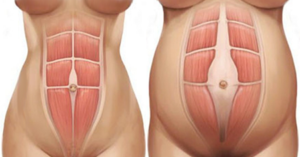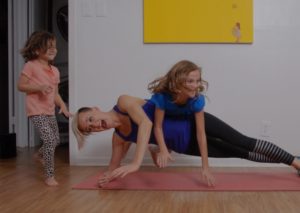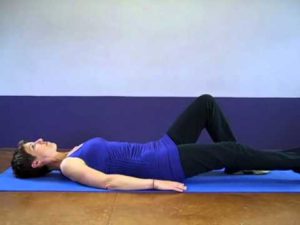“The Pooch.” Many women know that term well. A stranger at the grocery store asks you “When are you due?!” to which you reply with a sharp glance of rage. You are definitely not due anytime soon…because you are not pregnant. Whether you had your baby a few months ago or years ago, dealing with your postpartum body can be a process. One challenge that is extremely common is the separation of the abdominal muscles known as diastasis recti.In short, it’s a gap in between your right and left abdominal wall muscles that can result in a rounded, protruding belly “pooch.”
Did you just look down at your belly?
Why the heck did this happen?
Although a single event like pregnancy does not cause it, it can be the straw that breaks the camel’s back. As your baby grows during pregnancy, your uterus pushes against your abdominal wall while hormones allow the connective tissue to relax and soften. As this pressure increases the right and left side of your abdominal tissue begin to widen at the linea alba, which is the connective tissue where your abdominal muscles meet.
 Muscles and tissue that are loose and weakened from diastasis recti significantly affect the health and stability of our pelvis and spine. About two-thirds of women have diastasis recti postpartum.
Muscles and tissue that are loose and weakened from diastasis recti significantly affect the health and stability of our pelvis and spine. About two-thirds of women have diastasis recti postpartum.
Measuring DRA by the number of of finger spaces that fit in between the abdomen:
Normal: 1 Finger Separation or Less
Diastasis Recti: 2 or more finger spaces
Do I have Diastasis Recti?
To test yourself you can follow these few steps…
- Lie on your back with your knees bent, and the soles of your feet on the floor.
- Place one hand behind your head, and the other hand on your abdomen, with your fingertips across your mid-line, parallel with your waistline, at the level of your belly button.
- With your abdominal wall relaxed, gently press your fingertips into your abdomen.
- Roll your upper body off the floor into a “crunch,” making sure that your rib cage moves closer to your pelvis.
- Move your fingertips back and forth across your mid-line, feeling for the right and left sides of your abdominal muscles. Test for separation at, above, and below your belly button.
What can I do to heal?
You can heal! Through combining exercise, mindful posture and seeking support locally and utilizing online resources you can make progress to grow into a stronger you.
Ask the Experts! 
Courtney Wyckoff, CPT, CES, Founder of Momma Strong
Bracing Exercise
Step 1
- Lay down flat on your back
- Straighten one leg to the ground and keep one leg bent, foot planted into the ground
- Place one hand on the belly and one under the low back
- Deep breathe into the belly, as you breathe in expand the belly
- Exhale and press the belly to the spine, without moving the spine
Step 2
- Inhale, breathe into your belly
- Exhale,bBelly to your spine
- Tighten your pelvic floor (aka Kegel) squeezing up towards your pubic bone
Without moving your pelvis
Step 3
This step is aimed to support the mid back (right your bra strap hits). Think of a point in the middle of your bra strap that goes all the way through you connecting to your mid-line (center of the head/down the spine).
Stand up, legs hip distance apart and visualize that point connecting your mid back to the mid-line
Not splaying your rib cage forward
Then proceed to the exercise…
- Inhale, breathe in your belly
- Exhale, belly to spine
- Kegel (lift your pelvic floor)
- With gentle forward pressure tacking the mid back to the mid-line
Keep your pelvis neutral/no tuck, tilt or movement
BRACE ALWAYS!
List of when to practice bracing:
- Driving
- Doing dishes
- Brushing your teeth
- Holding kids
- Lifting or carrying heavy things
- Sitting at your desk
- Standing in line
- Other exercise
 Jennifer Gianni, Owner/Director of Fusion Pilates Asheville
Jennifer Gianni, Owner/Director of Fusion Pilates Asheville
Should I bind this area?
It is very common for women with a diastasis recti to constantly be wearing compression garments. The hope is that these garments will help heal the separation and bring the muscles and tissue back together. Nothing could be farther from the truth. It is very helpful to wear these garments in the first 6 to 12 weeks right after delivery to give extra support and stability but after that the body should be taking up the slack.
Reclined Strengthening Exercise
- Lay flat on your back
- Imagine a line or wire connecting the anus to the back of the pubic bone and connect along this line as if to draw the anus to the back of the pubic bone without moving your bones.
- Try to activate this on a slow, tension free exhale.
- Rest for at least 30 seconds between reps.
- Next put your fingers on the front of the pelvis at the inside of your hipbones. Your fingers should be pressing into your tissue.
- Engage the pelvic floor again and you should feel your fingers being drawn in and apart. No bulge upward into your fingers should be felt. If so decrease the effort and tension in your breath.
- Next put your fingers on the biggest part of your split at the mid-line of your abdomen.
- On your exhale slowly float one leg up into table top and slowly back down.
- Ideally, there should be no bulge of tissue into your fingers and no movement of the bones of your ribs or pelvis.
Local Resources
- Jennifer Gianni; Pilates Instructor FusionPilatesAsheville.com
- Ruth Elliot; Physical Therapist (Asheville, NC) http://ashevilleholisticpt.com
- Libby Hinsley; Physical Therapist (Asheville, NC) http://ashevilleholisticpt.com
Online Resources
- http://www.mommastrong.com
- Julie Wiebe; Physical Therapist http://www.juliewiebept.com
- Katy Bowman; Physical Therapist https://nutritiousmovement.com
- https://mutusystem.com

